‘Over 11,936 SHG members transformed into Lakhpati Didis under JKRLM’
JAMMU: Secretary, Rural Development Department and Panchayati Raj (RDD&PR), Mohammad Aijaz Asad, on Monday chaired a meeting of the steering committee to review implementation of Lakhpati Didi initiative under the Jammu & Kashmir Rural Livelihoods Mission (JKRLM).
The flagship program aims to economically empower rural women by ensuring an annual household income of Rs1 lakh through sustainable livelihood interventions.
The UT of J&K has been assigned a target of supporting 2.33 Lakh potential Lakhpati Didi Households to be transformed into Lakhpati fold over a period of 2 years. A total of 11,936 households have successfully transitioned into the Lakhpati fold till now.
The meeting was attended by Mission Director JKRLM, Shubhra Sharma, Chief Operating Officer, Himayat (DDU-GKY), Rajneesh Gupta, Joint Director, Industries and Commerce, Jammu/Kashmir, Director, Social Welfare, Jammu/Kashmir, Joint Director Handicrafts & Handlooms, Jammu/Kashmir, Director, Animal Husbandry, Jammu/Kashmir, Nodal officer, RSETI, J&K and others.
Addressing the meeting, the Secretary emphasised the need for devising a comprehensive vision document of the Lakhpati Didi initiative to align government schemes with target areas, streamline processes and ensure efficient delivery.
“We need a complete vision document to streamline our efforts. It should scientifically and comprehensively map Self Help Groups (SHGs) with potential livelihood activities across sectors such as handicrafts, dairy farming and aquaculture. Our aim is to achieve measurable milestones every six months,” maintained the Secretary.
Aijaz Asad highlighted the role of capacity building, proposing the appointment of master trainers to equip SHGs with the necessary skills. He also advocated for a robust dashboard and portal system to track group activities, income generation, and progress.
“Verification and mapping are crucial for ensuring that potential beneficiaries genuinely fall under the identified brackets. This initiative should not just be a one-time effort but an ongoing process to foster social mobility and economic empowerment,” he remarked.
The Secretary underscored the importance of convergence among various government schemes and departments to achieve tangible outcomes. He said that aligning key departmental schemes like MGNREGA, PMAY-G, and Agriculture and Horticulture Development Programs with the Lakhpati Didi initiative will create an integrated support system.
Aijaz Asad also noted that line departments, especially those dealing with agriculture, industries and trade, should support rural enterprises by providing access to markets, technology, and financial services.
“The success of Lakhpati Didi initiative hinges on effective collaboration and resource integration across departmental schemes. Our focus should be on equipping Self-Help Groups (SHGs) with the tools and resources needed to achieve their goals,” he said.
He directed the officials to prioritise identifying and supporting more potential beneficiaries, particularly women involved in agriculture, non-farm livelihoods, and rural enterprises.
The Secretary asked NRLM to promote high-value agriculture, livestock rearing, and non-farm activities to ensure sustainable livelihoods for rural households. He the directed field functionaries to identify successful Self Help Group (SHG) enterprises and replicate their models across other regions.
Mission Director JKRLM, Shubhra Sharma, provided an overview of the initiatives under the Lakhpati Didi program, emphasising the holistic efforts being made to empower women associated with self-help groups (SHGs). She said that the Lakhpati Didi initiative has already begun changing lives and women who once struggled to make ends meet are now emerging as successful entrepreneurs.
Shubra said that the Lakhpati initiative aims to enable rural households to achieve an annual income of Rs 1,00,000 or more, ensuring a sustainable monthly income of over Rs 10,000 across four agricultural seasons or business cycles.


